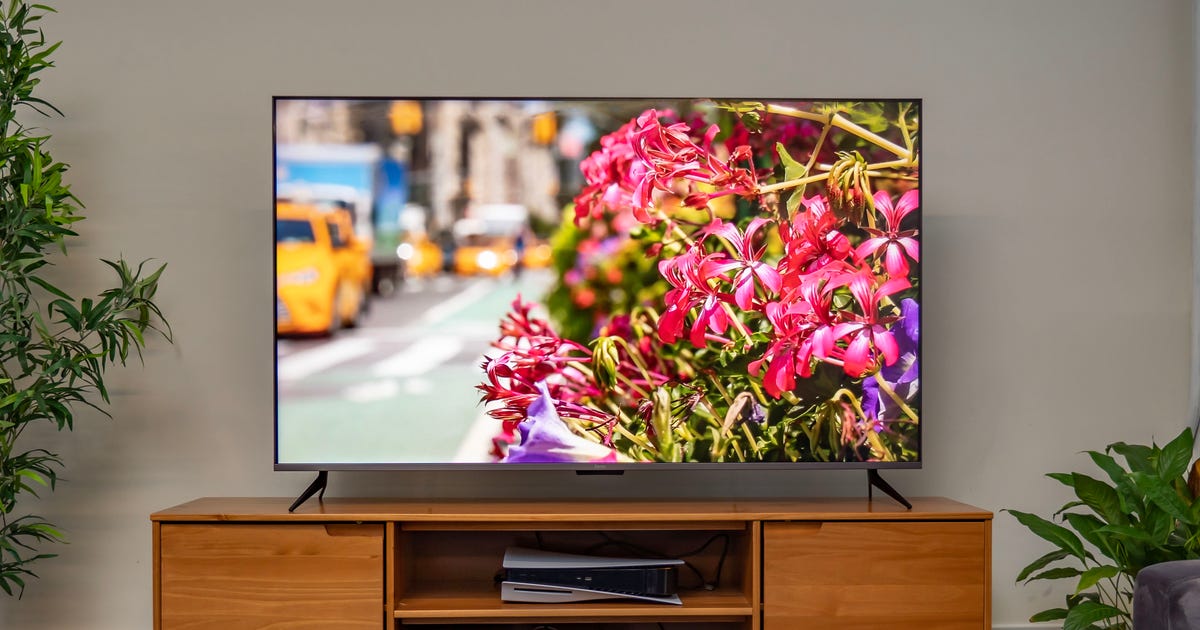
Roku may be known for its streaming devices, but it’s now making its own TVs as well. The company has long partnered with television manufacturers like TCL, Hisense, Sharp and others to produce TVs that feature Roku’s operating system. Some of these collaborations — such TCL’s 6-Series Roku TV, CNET’s pick as the best TV for the money — have been highly successful.
Roku’s new Plus Series TV reviewed here is something new. It’s all Roku, with no other brands on-board, and for now it’s available exclusively at Best Buy. In my comparison tests, the Roku Plus Series delivered midrange features and good image quality, with satisfactory color accuracy, but lower brightness than some competing models.
Like
- Affordable
- Good picture quality thanks to local dimming
- Great smart TV system
Don’t Like
- Lacks 120Hz refresh rate and other gaming extras
- Not as bright as some similarly priced TVs
Product details
| Sizes | 55-, 65-, 75-inch |
|---|---|
| TV Technology | LED with local dimming |
| Smart TV | Yes (Roku) |
| Resolution | 4K |
| HDMI Ports | 4 |
I included the TCL 6-Series in my head-to-head comparison, but the Plus Series is typically priced lower, more in line with TVs such as Amazon’s Fire TV Omni QLED, or the Vizio MQX. The Plus Series was somewhat dimmer than the Vizio MQX and on par with the Fire TV Omni QLED, albeit with a superior smart TV system. All three feature local dimming, which definitely improves their image quality over standard TVs, but none can match the contrast, brightness and overall image quality of the 6-Series.
If you’re looking for a quality TV and the 6-Series falls outside your budget, however, and you don’t need cutting-edge gaming features, the Roku Plus series could be an option for you — especially if it’s on sale. Otherwise, your best bet is to go with the Vizio MQX, its gaming-friendlier 120Hz input and brighter display.
Roku Plus Series sizes
I performed a hands-on evaluation of both 55-inch and 65-inch Roku Plus Series TVs and there were notable differences between the two units. The 55-inch version, which we independently purchased, has worse contrast than the 65-inch unit that was sent to us by Roku. That being said, all sizes have very similar specs and in theory should provide very similar picture quality.
Roku also makes a step-down series of TVs called Roku Select. These range in sizes from 24 to 75 inches, but lack QLED technology with full-array local dimming, Dolby Vision and Atmos and other high-end features, so they won’t match the Plus for picture quality. 4K Roku Select models start at 43 inches, while smaller units get stuck with HD. The 24- and 32-inch models max out their resolution at 720p, though the 40-inch version gets full 1080p HD.
Design: Hey Roku, great remote
The design of the Roku Plus Series looks similar to other TVs in this category. It sports thin bezels around the sides of the television, with a larger strip at its base. There is a small, plastic structure that protrudes about an inch below the Roku logo at the bottom of the screen. Both the TCL 6 Series and the Amazon Fire TV Omni QLED feature a similar construction — though the bump on at the bottom of the Plus Series is slightly larger and more conspicuous.
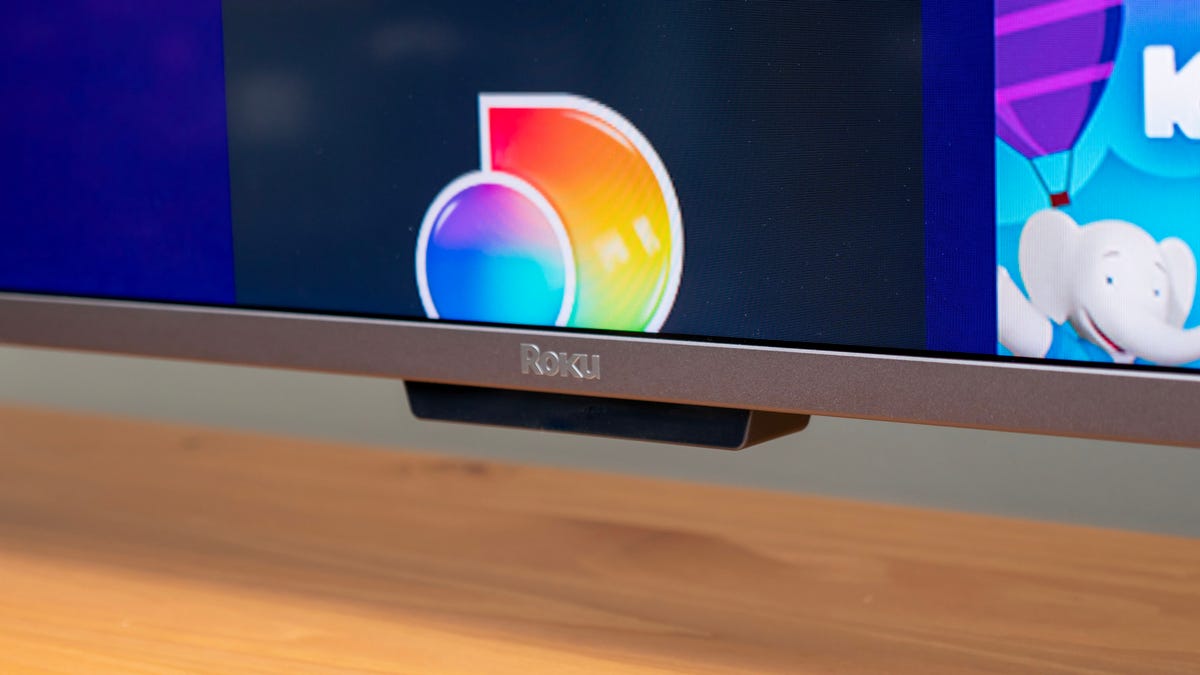
The Roku Plus Series has a small, plastic bump that protrudes from the bottom of the device.
Josh Goldman/CNET
All Plus Series Roku TVs come with the excellent Voice Remote Pro. This rechargeable remote features an always-on midfield mic that listens for your commands. This comes in particularly handy if you ever manage to lose your clicker. Just say, “Hey Roku, find my remote,” and the device will start beeping. Once you find it, you can press any button to make it stop. It’s a useful device that makes navigating TV easy and I’m happy to see Roku include it in the package.
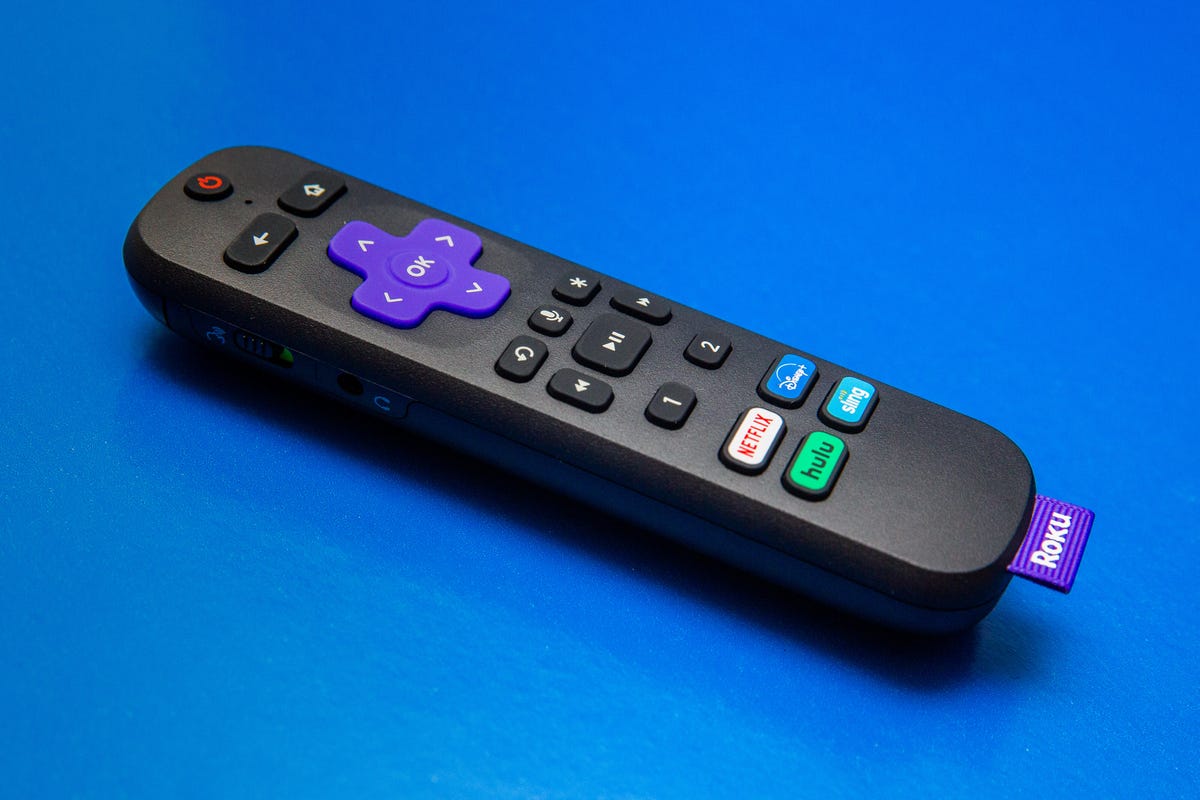
All Roku Plus Series TVs come with the Voice Remote Pro.
Sarah Tew/CNET
Naturally, Roku’s own TV comes with its popular operating system, which has long been my favorite. I find it easy to navigate to my individual apps and its search function makes it easy to find anything I want to watch. That said, I noticed that an advertisement for a Roku movie recently popped up in the side navigation bar. I find this to be deeply troubling and its continued presence might make me rethink the system overall.
I don’t mind an occasional promotion here and there, but I vehemently dislike when it affects my ability to quickly navigate to where I want to go. In this case, the offending ad sat in the midst of the main navigation menu, which meant that I had to click past it in order to reach my settings. I don’t appreciate being forced to interact with advertisements, even if that interaction is as simple as skipping past it. One of Roku’s biggest strengths is that it has historically kept its on-screen ads to an unobtrusive minimum. If that changes, my feelings towards the Roku platform will as well.
Features: Full-array local dimming, but only 60Hz
Key features
| Display technology | LED LCD |
|---|---|
| LED backlight | Full array with local dimming |
| Resolution | 4K |
| HDR compatible | HDR10 and Dolby Vision |
| Smart TV | Roku |
| Remote | Voice Remote Pro |
The Roku Plus Series sports a QLED screen with local dimming and Dolby Vision, but is stuck at a 60Hz refresh rate. Its technology is decidedly below the more expensive TCL 6-Series Roku TV, which comes with both brighter mini-LED technology and a faster 120Hz display. The Vizio MQX, however, is only slightly more expensive than the Roku Plus Series, but includes a 120Hz display.
I have to say that I really wish that Roku had matched Vizio on the 120Hz display on the Plus Series. There are few midpriced TVs that can take full advantage of the capabilities of the latest game consoles, namely PlayStation 5 and Xbox Series X, and the Vizio MQX is one of them. Roku had the opportunity to position the Plus Series as an affordable gaming television, but instead stuck with the 60Hz display like the one found on the Fire TV Omni QLED. This omission makes the Plus Series a tough sell to those looking to get the most out of their gaming, especially since its price is similar to the MQX.
On the plus side, Roku finally added a way to connect Bluetooth devices directly through the settings menu on the TV. Previously, users needed to pull out their phones and use the Roku app in order to listen to TV with their headphones. This feature was ridiculously long overdue — literally every new TV has this ability — but I’m glad that I finally don’t need to drain the battery on my phone in order to watch TV without disturbing my roommates.
The selection of inputs on the Plus Series is good, with four HDMI ports. The Plus Series also sports classic red, white and yellow audio jacks for analog outputs instead of the usual minijack found in many TVs.
- Four HDMI inputs, one with HDMI eARC
- One USB 2.0 port
- Optical digital audio output
- Composite Input
- Cable/RF (antenna) input
- Ethernet (LAN) port
- Headphone jack
One potential design issue becomes apparent when looking at the back of the TV. The Plus Series comes with four HDMI ports, but only two of them are placed on the side of the device and are therefore readily accessible. The other remaining HDMI ports, along with the USB, LAN, composite input and cable/antenna connection are all located at the bottom of the TV, and I found them extremely difficult to access — especially when the TV is mounted to the wall. I found it impossible to connect a USB stick to the TV without standing in the back of the television, for example.
Picture quality comparisons
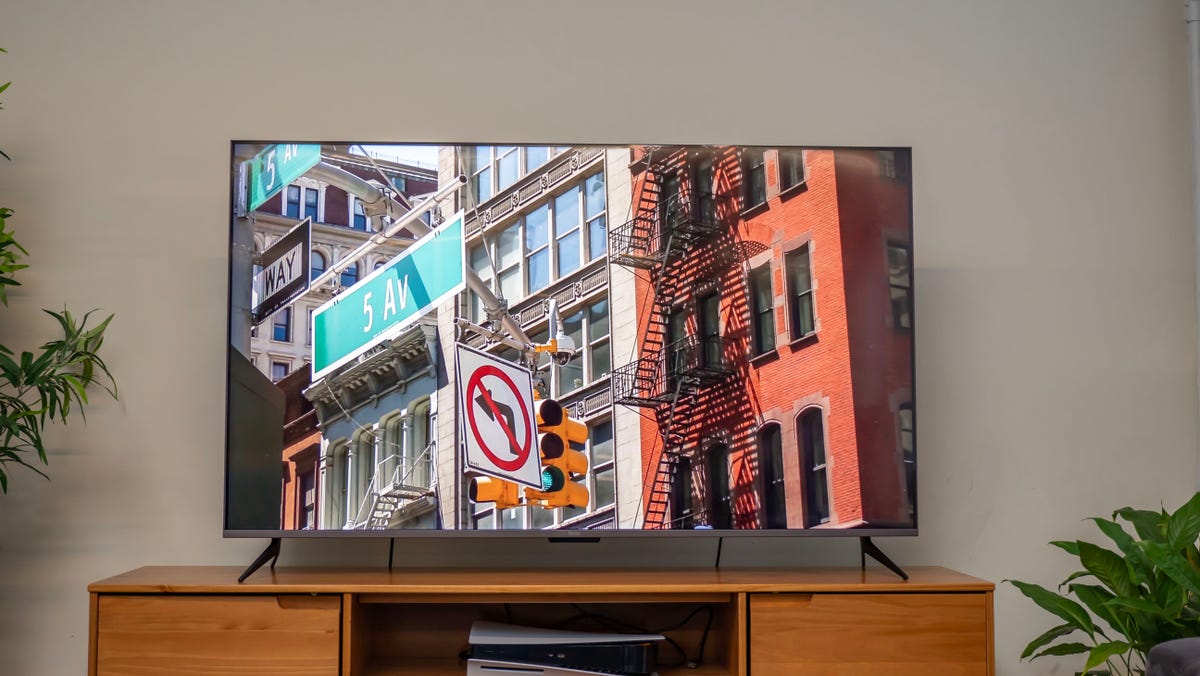
The Roku Plus Series looks good in a dark and light room.
Josh Goldman/CNET
TV and movies: For my picture comparison I set up the 55-inch and 65-inch Roku Plus Series next to three other 65-inch TVs, the Amazon Fire TV Omni QLED, Vizio MQX and TCL 6-Series. All of these TVs offer full-array local dimming, but only the TCL 6-Series comes with a mini-LED display — and a steeper price.
Both Roku Plus Series sizes handled color fairly accurately, but lacked a little brightness and contrast compared to the others, especially in the 55-inch version. The difference in brightness and impact between the Roku Plus and two other TVs — the TCL and Vizio — was obvious in my side-by-side comparison of watching nature videos on the Spears & Munsil HDR benchmark. While I expected the more expensive 6-Series to be better, the Roku’s brightness was disappointing compared to the similarly priced Vizio MQX. An image of the grazing cows looked dimmer on the Roku Plus and the green of the grass at the cows’ feet appeared lifeless and dull, while it looked vibrant and colorful on the Vizio.
Objects against a black background fared better on the 65-inch Plus Series TV than they did on the 55-inch. The cactus blooms in our 4K HDR test pattern were nice and bright on the 65-inch Plus TV, while the background maintained its relatively inky shade of black. On the 55-incher, however, black areas appeared uniformly lighter, losing contrast around the edges of the dripping honey and in dark cityscapes.
This was particularly apparent when watching theatrical content. The 55-inch Plus Series appeared somewhat washed out during the many dimly lit scenes in the 4K HDR version of Shadow and Bone on Netflix. It was more difficult to make out details in a dark tent or to see the full intricacies of the stitching on a black robe.
This changed dramatically when I switched to the 65-inch version. I could more readily make out the texture of the walls in a dimly lit passageway, as well as spines of books sitting on a shelf in the background. On the 65-inch model, the Roku Plus looked much closer to the MQX and the Fire TV Omni QLED in terms of black levels. And while the 65-inch Plus Series looked redder than either the MQX or the Omni, the overall quality between the three TVs was almost interchangeable.
When asked about the discrepancy between the two models, Roku suggested that our local dimming settings were set to medium instead of high on the 55-inch TV. We only used the default settings on both TVs and did not adjust local dimming manually.
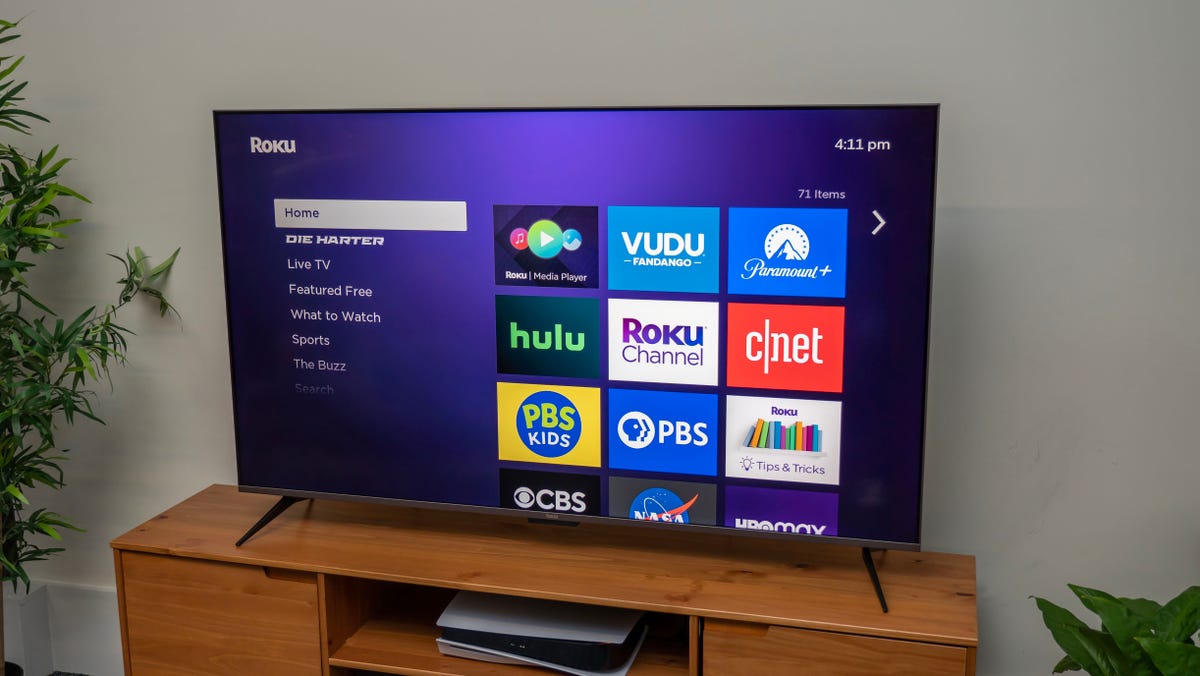
The Plus Series does a good job maintaining black levels.
Josh Goldman/CNET
Gaming: The Roku Plus Series is not designed specifically for gaming and lacks the 120Hz refresh rate found on the Vizio MQX and TCL 6-Series, as well as other gaming extras such as AMD Freesync or a variable refresh rate. In practice, this means that gaming on the Roku Plus Series is more in line with gaming on the Amazon Fire TV Omni QLED than it is with the other TVs.
One advantage Roku has over the Fire TV Omni QLED is that its game mode operates independently of other picture modes, so it’s possible to get the TV’s best input lag while also maintaining good picture quality.
This worked out well when playing the Xbox Series X. The Roku’s excellent 11.9-millisecond input lag meant that I had no issues winning a shootout in Far Cry 5. The lush forests of Montana appeared colorful when viewed in the Brighter Dark HDR picture setting, while I could make out the texture of leaves in the trees — even in night scenes.
Games on the Fire TV Omni QLED appear much brighter than on the Roku Plus Series, but the picture features a heavy blue tint with blown-out colors. The green meadows of Far Cry 5 appear almost neon on the Fire Omni QLED, while they look more earthy and natural on the Roku Plus Series.
Bright lighting: The Roku Plus Series is not nearly as bright as some of the other TVs we reviewed in this price range. We found the 55-inch version of the Plus Series to be brighter than its 65-inch counterpart — though both paled in comparison to the Vizio MQX and the TCL 6-Series.
Light output in nits
| TV | Brightest mode (SDR) | Accurate mode (SDR) | Brightest mode (HDR) | Accurate mode (HDR) |
|---|---|---|---|---|
| TCL 65R655 | 1,292 | 624 | 1,387 | 1,194 |
| Vizio M65QXM-K03 | 958 | 608 | 939 | 742 |
| Roku TV 55-inch | 620 | 461 | 581 | 552 |
| Roku TV 65-inch | 579 | 404 | 514 | 455 |
| Fire TV Omni QLED | 407 | 407 | 488 | 432 |
Roku’s Brighter Dark HDR mode loses a few nits from its peak brightness, but delivers the most accurate picture. There isn’t a significant difference in brightness between Brighter Normal HDR and Brighter Dark HDR, but there is in picture accuracy. In my opinion, it’s worth it to stick with Dark HDR, even in a brighter room.
In their most-accurate modes both the Vizio and the TCL were noticeably brighter when compared side-by-side with the Roku Plus Series — especially in a bright room. The Roku Plus series appears somewhat dimmer and less vibrant next to its brighter competitors.
However, the Roku Plus holds its own against the Fire TV Omni QLED. Both TVs offer plenty of light output for viewing in bright environments and appear almost interchangeable in their brightness levels. While the Roku technically gives out a few more nits of brightness than the Fire TV Omni, it’s almost impossible for the naked eye to tell the difference between the two. The Roku Plus might not bowl you over with brightness, but it will certainly get the job done.
Uniformity and viewing angle: Both versions that we tested of the Roku Plus did not have issues with uniformity. Neither of them had bright or dark spots on the screens, nor did they have any noticeable differences in picture between the edge of the screen and the middle. Neither did a particularly good job maintaining color and brightness from an off-angle, but the 65-inch version performed slightly better than the 55-inch. The 65-inch version looked slightly brighter and more vibrant from an off angle, but both need to be viewed directly in order to get the best experience.
Picture setting and measurement notes
Movie Mode was the best picture mode for non-HDR (aka SDR) content, and you should choose the brightness level (from Brighter to Darker) based on room lighting. For HDR content, on the other hand, we found Brighter (Dark HDR mode) best for HDR content regardless of room lighting. Those picture modes are our choices for both the 55- and 65-inch models of the Plus Series.
Geek box
| Test | Result | Score |
|---|---|---|
| Black luminance (0%) | 0.046 | Average |
| Peak white luminance (SDR) | 620 | Good |
| Avg. gamma (10-100%) | 2.22 | Good |
| Avg. grayscale error (10-100%) | 1.01 | Good |
| Dark gray error (30%) | 0.99 | Good |
| Bright gray error (80%) | 0.94 | Good |
| Avg. color checker error | 1.42 | Good |
| Avg. saturation sweeps error | 1.38 | Good |
| Avg. color error | 2.05 | Good |
| 1080p/24 Cadence (IAL) | Pass | Good |
| Input lag (Game mode) | 11.90 | Good |
| HDR10 | ||
| Black luminance (0%) | 0.006 | Good |
| Peak white luminance (10% win) | 580 | Poor |
| Gamut % UHDA/P3 (CIE 1976) | 96.49 | Good |
| ColorMatch HDR error | 3.87 | Average |
| Avg. color checker error | 3.88 | Average |
| Input lag (Game mode, 4K HDR) | 12.70 | Good |
See How We Test TVs for more details and explanations of the Geek Box results.
Portrait Displays Calman calibration software was used in this review.
David Katzmaier contributed to this review.
